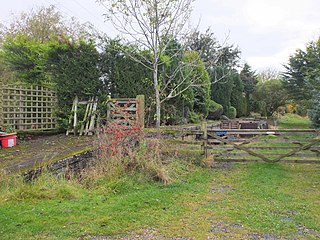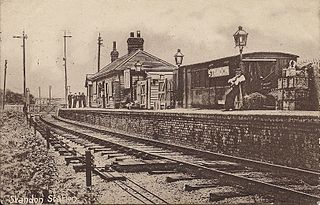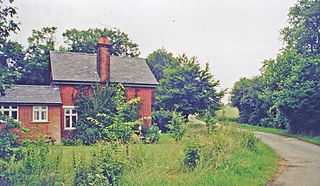
Feniton railway station serves the village of Feniton in Devon, England. It was opened by the London and South Western Railway (LSWR) in 1860 but is now operated by South Western Railway which provides services on the West of England Main Line. It is 159 miles 24 chains (256.4 km) down the line from London Waterloo.
Cockerham Cross railway station, also known as Cockerham Crossing railway station was a halt at a level crossing on a road that crossed Cockerham Moss towards Cockerham in Lancashire, England. It opened with the line in 1870 and closed in 1930.
Wark railway station is a disused railway station which served the village of Wark on Tyne, Northumberland, England. Located on the Border Counties Railway, the station was possibly opened on 1 December 1859, but was definitely open by 1 April 1860. The station was originally connected to the village by a wooden bridge over the River Tyne but this was replaced by an iron bridge in 1878. There was a single platform, a small goods shed with a signal box being added in 1896. It was closed to passengers on 15 October 1956 and completely on 1 September 1958.

The Railway of Kelso and Jedburgh branch lines was a 'network' of three distinct railway services serving Kelso in the Scottish Borders.

Scremerston railway station served the village of Scremerston, Northumberland, England from 1847 to 1951 on the East Coast Main Line.

Lucker railway station served the village of Lucker, Northumberland, England, from 1847 to 1965 on the East Coast Main Line.

Christon Bank railway station served the village of Christon Bank, Northumberland, England from 1847 to 1965 on the East Coast Main Line.

Longhirst railway station served the village of Longhirst, Morpeth, England from 1847 to 1964 on the East Coast Main Line.
Plessey railway station served the hamlet of Plessey, Northumberland, England from 1859 to 1962 on the East Coast Main Line.
Killingworth railway station served the town of Killingworth, Tyne and Wear, England from 1847 to 1965 on the East Coast Main Line.

Coxhoe railway station served the village of Coxhoe, County Durham, England from 1838 to 1902 on the Coxhoe branch of the Clarence Railway.

Choppington railway station served the village of Choppington, Northumberland, England from 1858 to 1964 on the Blyth and Tyne Railway.
North Seaton railway station served the town of Ashington, Northumberland, England from 1859 to 1964 on the Blyth and Tyne Railway.

Backworth railway station served the village of Backworth, Tyne and Wear, England from 1847 to 1965 on the Blyth and Tyne Railway.

Waskerley railway station, also known as Waskerley Park, served the village of Waskerley, County Durham, England from 1845 to 1859 on the Stanhope and Tyne Railway.

Marston Moor railway station served the village of Long Marston, North Yorkshire, England from 1848 to 1967 on the Harrogate line.
Countess Park railway station served the village of Bellingham, Northumberland, England from 1859 to 1861, during the construction of the Border Counties Railway.

Carham railway station was located in the historic county of Roxburghshire, Scotland, from 1849 to 1964 on the Kelso Branch. It served the village of Carham in Northumberland, England.

Standon railway station served the village of Standon, Hertfordshire, England, from 1863 to 1965 on the Buntingford branch line.

Mardock railway station served the village of Wareside, Hertfordshire, England, from 1863 to 1964 by the Buntingford branch line.














